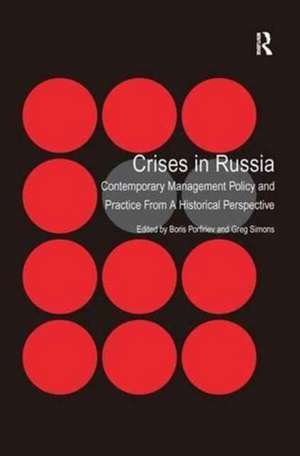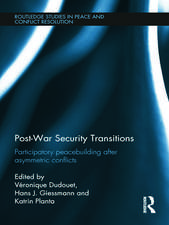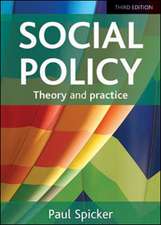Crises in Russia: Contemporary Management Policy and Practice From A Historical Perspective
Autor Boris Porfiriev Editat de Greg Simonsen Limba Engleză Paperback – 17 noi 2016
| Toate formatele și edițiile | Preț | Express |
|---|---|---|
| Paperback (1) | 469.34 lei 6-8 săpt. | |
| Taylor & Francis – 17 noi 2016 | 469.34 lei 6-8 săpt. | |
| Hardback (1) | 1063.41 lei 6-8 săpt. | |
| Taylor & Francis – 22 noi 2012 | 1063.41 lei 6-8 săpt. |
Preț: 469.34 lei
Nou
Puncte Express: 704
Preț estimativ în valută:
89.82€ • 93.43$ • 74.15£
89.82€ • 93.43$ • 74.15£
Carte tipărită la comandă
Livrare economică 14-28 aprilie
Preluare comenzi: 021 569.72.76
Specificații
ISBN-13: 9781138279100
ISBN-10: 1138279102
Pagini: 312
Dimensiuni: 156 x 234 mm
Greutate: 0.45 kg
Ediția:1
Editura: Taylor & Francis
Colecția Routledge
Locul publicării:Oxford, United Kingdom
ISBN-10: 1138279102
Pagini: 312
Dimensiuni: 156 x 234 mm
Greutate: 0.45 kg
Ediția:1
Editura: Taylor & Francis
Colecția Routledge
Locul publicării:Oxford, United Kingdom
Notă biografică
Boris Porfiriev is Head of the Risk and Crisis Research Center and Head of the Laboratory for Analysis and Forecasting of Natural and Technological Risks for Economic Development at the Institute of Economic Forecasting, Russian Academy of Sciences, and Director of the Center for Environmental and Technological Research at the International Research Institute for Advanced Systems, Russia. Greg Simons, Crisis Management Europe Programme at Crismart (Centre for Crisis Management Research and Training) at the Swedish National Defence College, Sweden.
Recenzii
Offers a unique overview of this giant’s weaknesses. The overlapping of responsibilities, and the tendency to mix institutions from different eras of development and institutional cultures, show how problematic incomplete reform is combined with the huge impact that civil emergencies and man-made crisis can have for an enormous centralized but anarchic bureaucracy.’ Iulian Chifu, Conflict Prevention and Early Warning Center, Romania ’In the increasingly interdependent world under circumstances of globalization, crises management in Russia is a significant issue, not only for countries like Latvia which are situated in the neighbourhood of this regional power, but for the whole of Europe. This study, involving both Russian and Western scholars, makes a great contribution to the field.’ Ainars Dimants, Turiba University, Latvia
Cuprins
Introduction; I: Transitional Crisis Management Policy and Russia; 1: Crisis Management and the Mass Media in Russia: Following the Historical Perspectives; 2: The Institutional Framework and Governance Model of Russia's Crisis Policy: Disaster Focus; II: Crisis Development and Management: Case Studies of Environmental and Technological Disasters; 3: Managing Alleviation of the 1995 Neftegorsk Earthquake Disaster: A Reminiscence 1; 4: Managing the Ecological Disaster in the Town of Karabash; 5: Communicating Tragedy and Values through the Mass Media During Crises: The Lessons of Submarine Accidents in Russia 1; III: Crisis Development and Management: Case Studies of Social and Political Conflicts; 6: Social Security Policy for the Chernobyl Clean-up and Rescue Workers: Crisis Chronology and Lessons; 7: Institutional Issues and the Management of the Creeping Crisis in the Kabardino-Balkaria Republic of Russia; 8: Political and Institutional Factors of the Russian Banking Crisis of 2004; IV: Transitional Crisis Management Policy: From Hypotheses to Findings; 9: Vulnerability and Crisis Development: Lessons from Russia and Other Emerging Economies; 10: Conclusion: Crisis Management Policy in Transitional Societies – Beyond the Russian Experience
Descriere
This unique book explores the problems of the national crisis management system in Russia, a country undergoing political, social and economic transition and one which is also prone to natural and man-made disasters. In detailing policy, institutional and legal issues and illustrating a number of case studies, the authors offer new ways of resolving the effects of disasters as well as increasing resilience by improving our understanding of the risks and vulnerabilities.














